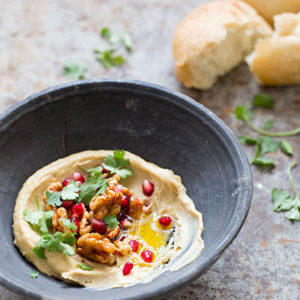 I love to eat this variation of hummus in the fall with grated radishes or pomegranate seeds sprinkled over top. There is something extremely decadent about serving the warm walnuts in the center of this hummus. You’ll want to do it every single time.
I love to eat this variation of hummus in the fall with grated radishes or pomegranate seeds sprinkled over top. There is something extremely decadent about serving the warm walnuts in the center of this hummus. You’ll want to do it every single time.
— Ana Sortun
On-Demand: Listen to Faith and Ana talk about this hummus (as well as other recipes like Green Apple Fattoush, Sesame Cashew Bars, and Maura Kilpatrick’s Tahini Hot Chocolate) when Ana was a guest on The Faith Middleton Food Schmooze®.
 Reprinted with permission from Soframiz by Ana Sortun and Maura Kilpatrick, 2016. Published by Ten Speed Press, an imprint of Penguin Random House LLC.
Reprinted with permission from Soframiz by Ana Sortun and Maura Kilpatrick, 2016. Published by Ten Speed Press, an imprint of Penguin Random House LLC.
Photographs copyright © 2016 Kristin Teig
- 1 cup dried chickpeas soaked overnight in 6 cups water
- Pinch baking soda
- 1 teaspoon kosher salt plus more to taste
- 2 cloves garlic peeled
- 1 teaspoon ground cumin
- 3 tablespoons freshly squeezed lemon juice
- 6 tablespoons tahini (see Recipe Note)
- 2 tablespoons extra virgin olive oil
- 1/4 cup walnut oil
- 1/2 cup coarsely chopped walnuts
- 1 tablespoon unsalted butter or extra-virgin olive oil
- 1 teaspoon Maras pepper (see Recipe Note)
- 1/4 cup pomegranate seeds
- 1/4 cup coarsely chopped fresh cilantro leaves
- Drain the chickpeas and combine them in a large saucepan with 6 cups fresh water. Add the baking soda and bring to a boil over high heat. Lower the heat to medium-low and simmer until tender and almost falling apart, about 45 minutes, using a ladle to skim any foam that rises to the surface. Add 1 teaspoon salt, stir, and set aside for 5 minutes to absorb the salt. Reserve 1⁄2 cup of the cooking liquid and drain in a colander.
- Preheat the oven to 350°F.
- Put the garlic in a food processor fitted with a metal blade and process until finely chopped. Add the chickpeas and blend until finely ground and starting to resemble cookie dough. The chickpeas will form a ball in the machine as they become smooth enough. Add the cumin, lemon juice, and half of the chickpea cooking liquid and process. Add the tahini and oils slowly in a smooth stream as the machine is running, stopping once to scrape the sides of the bowl. Add 1 to 2 tablespoons more of the cooking liquid if it seems too thick. The consistency should be creamy, like mayonnaise. Season with sale to taste.
- Put the walnuts on a baking sheet. Melt the butter in a small saucepan and pour it over the walnuts. Toss the walnuts to coat them evenly with the butter and roast until they are lightly toasted, about 7 minutes. Sprinkle with Maras pepper and lightly season with salt to taste.
- To serve, scrape the hummus into the center of a large shallow serving bowl, forming a large mound in the center of the bowl. Use the back of a large serving spoon and, starting from the center, smooth it around towards the edges of the bowl. As you smooth the hummus, create a lip on the outer edge. Try to form a large, shallow 1⁄2-inch deep well in the center to hold the walnuts. Sprinkle the pomegranate seeds and cilantro evenly over the center. If the walnuts have cooled, warm them again in the oven for 4 minutes and evenly distribute them in the center over the pomegranate and cilantro. Serve immediately.
Tahini - This paste is made with hulled sesame seeds. It has a bittersweet, nutty flavor and a wonderful creamy texture. Tahini is an essential ingredient in many signature Middle Eastern dishes, among them hummus and baba ganoush. Some commercial tahinis are very bitter, often rancid, and have a chalky texture. If the tahini seems bitter, try adding some salt, which will help pull some of the bitterness out. As the sesame paste sits, the oil separates, so the mixture should be stirred before it’s used. We recommend storing it in the refrigerator after it’s opened. We love the brand Tohum, which is a dark-roasted organic tahini from Turkey (tohum.com). It is available at specialty grocers or on Amazon. We also recommend the super-fresh tahini from Brooklyn Sesame, which you can order at brooklynsesame.com, and the ultra creamy Soom brand from Philadelphia (soomfoods.com), which you can find online from several sources.
Maras Pepper or Aleppo Pepper - True Aleppo pepper hasn’t been available since the crisis in Syria began. In southeastern Turkey, not far from the border with Syria and around the city of Kahramanmaras, is the Maras region, where these sweet oily peppers thrive and are usually what is imported and labeled as Aleppo pepper. You will find a shaker of Maras red pepper flakes on the table in every kebob joint in Turkey. Bright red, brightly flavored, and oily, with a bittersweet, slow, mild heat, these peppers broaden all the other flavors in a dish.
You can replace those red pepper flakes that you have in the cabinet (the ones that you see in a shaker in a pizzeria) with Maras pepper. It will change your life and your recipes for the better. If you don’t go through it as fast as we do, keep some on hand in the freezer. Our friends and neighbors at formaggiokitchen.com (located in Cambridge) have beautiful Maras pepper.


